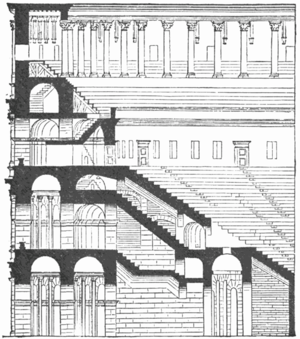Difference between revisions of "Entrances and Exits"
(No difference)
|
Latest revision as of 20:43, 10 January 2023
Crowd management in antiquity
Crowd management is a vital part of live events, and the larger the audience, the greater the care needed. The architectural principles for the flow of people in venues used today were established in the theatres and amphitheatres of Antiquity.
The theatres of ancient Greece were attended by all the citizens of the city. They therefore gathered large crowds. To enable everyone to attend, the Greek theatre used natural slopes on which to place wooden benches for the audience, with a circular platform called the orchestra for the chorus and a raised floor for the actors (E.01). Later, stone structures were built. The semi-circular seating area was divided into several overlapping sectors separated by aisles, and radial steps divided the auditorium into a series of wedges. The seats comprised an upper tier on which the spectators sat, and a lower one on which they placed their feet. There was, at the bottom, a row of seats of honour intended for priests and official figures. The auditorium was usually built by excavating or adapting the natural slope of the ground. At the sides were two entrances placed between the ends of the semi-circular seating area and the stage. The audience had to pass through the orchestra and then climb up to occupy the upper seats. The entire audience therefore had only two entrances and exits – shared, moreover, with the actors and the chorus. The entrance was therefore slower and had to be disciplined; only after entering could one disperse onto the auditorium.
The Greek theatres stood in sacred areas near temples and were built on slopes. The Roman theatres, on the other hand, were built in cities and were freestanding buildings, thanks to the Romans’ knowledge of arch and vaulting, mortar and brick – methods unknown to the Greeks. The semi-circular tiers of seats in the auditorium now rested on brickwork arches and vaults, and connected to the stage with side galleries. This allowed the theatre building to be placed anywhere, and gave scope for an ornate and monumental external façade – in the imperial age – embellished with precious marbles. The spectators used several entrances, through various arches on the semicircle at ground level, and then walked along corridors, ascending to the upper levels through internal corridors and stairs, up to six storeys high, and then exiting to their assigned sector through the vomitators. The public therefore had independent entrances and exits, sheltered and enclosed spaces with many ways in and out of the auditorium at different levels. With this system of stairs and tunnels, the public could exit in just a few minutes and take their seats very comfortably and quickly, even in large theatres – the Roman theatre of Ostia Antica could hold 2500 people (Q30630).
The Roman amphitheatre was of a similar design, but elliptical in shape rather than semi-circular. The name ‘amphitheatre’ means ‘spectator space running around the arena’. The centre of the amphitheatre consisted of a flat elliptical area covered with sand, called the arena. All around it was the auditorium, again with masonry tiers, where spectators took their seats. These tiers were usually divided into sectors, so that spectators of different social class and category would not be mixed.
The number of spectators in the amphitheatre compared to the theatre was much greater. The Colosseum in Rome (Q615) could accommodate up to 70,000 spectators. There were 76 entrances through the arches on the ground floor, each marked with a number. The spectators, from outside, could already tell, with ticket in hand, where it was best to enter. Once inside, they found themselves in a circular corridor (ambulacrum), which led them under the tiers of seats, which they accessed by climbing the stairs and passing through the vomitorium to the auditorium. Any doubts about which way to go were resolved by signs with directions.
This type of construction ensured disciplined entrance and exit movements that did not create traffic jams. Thanks to the very efficient system of stairs and galleries, the public was able to take their seats very comfortably and quickly, and after the show exit again in a very few minutes. The use of multiple entrances/exits, the use of internal spaces, created by arches and corridors, ensured that the quantity of people was always spread throughout the entire structure, so that unmanageable or dangerous crowds never formed.
Large sports stadiums today use the same principles for distributing the spectators through various entrances, and then using the interior spaces as a further subdivision of the flows of people. The Colosseum’s capacity of 70,000 would put it in the top ten of the largest Olympic stadiums today. 2500 years ago, the Romans had mastered the principles of crowd safety. They even placed a separation between the crowd and the arena so there could be no equivalent of the modern day ‘pitch invasion’.






